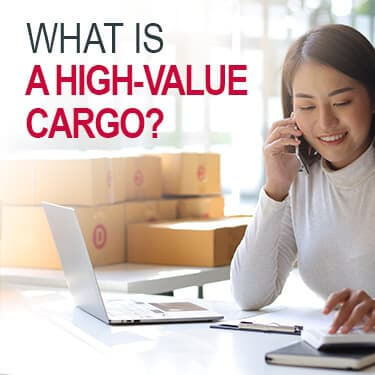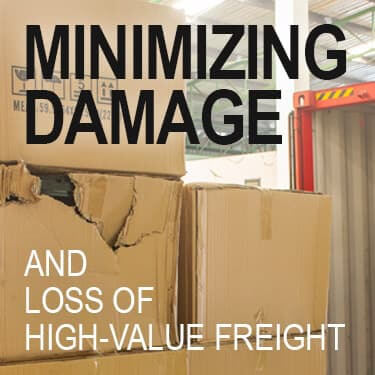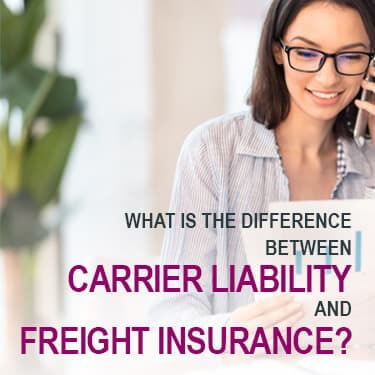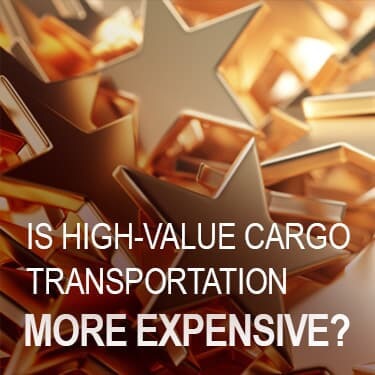High value cargo transportation is often viewed as a high-risk but high-reward kind of haul. Depending on what kind of high value freight you plan on shipping, there are different precautions to take. At a time when it’s harder than ever to get items shipped, you should be extra careful about making sure your high value cargo gets to its destination.
The Transported Asset Protection Association (TAPA AMERICAS) is one of the organizations dedicated to preventing cargo theft in the transportation industry. A high value shipment is considered to be anything worth over $100,000. This can include construction equipment, high-end technology, or other valuables shipped in bulk.
Find out what kind of cargo is most vulnerable and what steps can lower the risk of damage and theft.
According to Verisk supply chain tracking, in 2021 alone, it's estimated that over $57 million dollars worth of cargo was stolen from warehouses, trucks, and ports. If you have planned shipments of high value cargo that you need to transport, that is a scary statistic.
While that amount is not exclusive to high value cargo, it does represent the fact that cargo theft can and does happen. In terms of recovering lost freight, shippers and carriers are usually out of luck. While the value of lost freight can sometimes be recovered through insurance policies and freight claims, those solutions don’t put items in consumers' hands.
Add the fact that cargo thefts are considered a property crime and may be low on the priority list of law enforcement agencies. Places with high numbers of cargo thefts tend to have plenty of other crimes too. For a police report to be completed, you also have to know exactly where the theft occurred.
Since stolen freight usually isn’t discovered until it fails to show up at its destination, pinpointing the place of the theft is sometimes impossible. These events further reduce the possibility of actual freight being recovered.
Instead of focusing on recovering lost cargo, it's better to take whatever steps you can to prevent your high value cargo from being stolen or damaged in the first place.

Most freight companies would consider anything valued at $100,000 or more to be high value. This is because $100K is usually the liability limit for most carriers.
A surprising amount of cargo can be considered high value, some less obviously so than others. While we won’t argue that high-end jewelry or certain art pieces can easily tip the 100K scale, most of these wouldn’t be shipped via standard freight services.
Some of the most common high value cargo would include:
A bit less common would be dry van loads of:
Considering the rising prices of lumber in the United States, a flatbed of standard construction lumber just might be considered high value these days.
The risks associated with shipping high value cargo will depend on different factors. Not every high value load is prone to the same risk so there is no blanket solution to the problem.
Since high value cargo usually translates to high liability, the monetary risk taken by shippers and carriers is considerable.
On the carrier’s part, damage or theft could result in extremely high claim payouts. They would want to ensure that loads are well secured from such risks to avoid freight claims.
The shipper faces risk as well, even if freight claims allow for some money to be recovered. There is no claim that can turn back the clock when goods cannot get delivered.
Other risks will be specific to the type of high value goods being moved as well as where and when the shipment is taking place. Common concerns may include:
Let’s look at a couple of different scenarios where risk is dependent on circumstances.
A commercial excavator often seen at highway construction sites is worth anywhere from $100,000 to $500,000, but the chances of it being stolen off the truck or even from the construction site are pretty low. Transport service in the summer across mostly flat terrain would also be fairly low risk in terms of possible damage.
Take that same excavator, but now set the transport services in the Rocky Mountains of Colorado during winter. The risk to the load, as well as to the truck and driver, is now much higher. The fact that it’s valuable cargo just adds to the stress of the situation.
In another scenario, imagine you have a reefer container full of 5,000 pounds of frozen king crab. This delicacy averages about $60 per pound. That’s $300,000 worth of crab meat. If something were to malfunction with a reefer container, that’s over a quarter-million dollars lost.
Contracting with reliable and vetted carriers with a history of success goes a long way in reducing damage. Especially in terms of transporting valuable items, you will get what you pay for (or don’t pay for).

When it comes to moving high value commodities, there are ways to reduce the risk of damage or loss. This is especially important if you need to safely transport a high value product that is also fragile.
In the case of shipping an excavator to the Colorado Rockies, maybe you can’t avoid the location, but you can plan ahead and perhaps avoid shipping during the winter when accidents are more frequent.
Certain times of day and even days of the week are better off avoided. Loading high value freight like televisions or laptops late at night is asking for trouble. Likewise, you may want to avoid shipping on weekends which is when the most cargo thefts are reported.
When it comes to shipping fragile items, you want to look into specific services provided by carriers. Some forms of transport are more likely to cause damage. You may wish to ask the carrier if they provide any of the following services:
Each of these services offers something in the way of cargo protection or reduces risk of damage by reducing handling and touchpoints. Shippers need to do their part as well. Always make sure that items are properly boxed, if possible, and correctly palletized to reduce unnecessary movement during transit.
Proper use of packing materials goes a long way to keeping materials safe and secure during travel.
For more information on keeping cargo secure, check out our article on reducing freight claims.

Of course, the risk of high value cargo being stolen can’t be ignored. As mentioned, millions of dollars worth of freight are stolen each year. Between the amount stolen, payouts from insurance companies, and the need to re-order goods, you’re looking at a billions of dollar problem long term.
Some commodities are going to attract more risk for being both valuable and easy to re-sell. Cosmetics, as an example, are lightweight, easily sold, and contain no tracking technology. It disappears very quickly in the wrong areas.
According to the theft recording form CargoNet, there were 1,285 reports of stolen cargo in 2021 - an average of 3.5 per day. The average value per theft was $172,340.
The greatest number of thefts were recorded in California, Texas, and Florida, accounting for 49% of the total value of stolen goods. Each of these states has ports processing millions of goods from around the world and populations dense enough to have quick re-sell opportunities.
Stolen freight can affect more than just a shipper’s pocket though. There are other risks involved when high value shipments are stolen.
If the theft is public enough, it can cause social turmoil and/or even give rise to copycats who think they can get away with the same things. There are also incidents of a driver leaving a truck unattended and coming back to an empty parking spot. In such a case, not only is the valuable cargo lost, but also the truck, which can prove disastrous to drivers who are owner/operators.
High value cargo is something of a necessity for shipping companies. Oftentimes carriers and truckers rely on these high ticket items for a good part of their profit.
With that being said, even though nearly all companies provide some kind of high value cargo transport, it doesn’t mean they will all be equal. Some companies may have their own standards for what they consider to be high value based on company liability plans. They may also place a maximum declared value amount.
One company may set its high value threshold at $50,000 and another may set it at $250,000. Oftentimes it has to do with what kind of cargo or clients a company wishes to attract.
This doesn’t mean that a carrier won’t take shipments over a certain amount. Depending on the shipper, you may have a few options. You may be able to ship your high-end commodities, but with the understanding that if something does happen to your cargo, the carrier is not responsible for anything above a set liability amount.
A second option is to secure freight insurance, which can cover the value of freight above that of the carrier's liability limit. With most insurance, the hope is that you never actually have to use it. After all, having your cargo in hand to sell and make a profit from is worth much more than its base value.
While standard shipments are relatively inexpensive to insure, realize that may not be the case with more expensive or out-of-gauge commodities. Cargo insurers are likely to charge a higher premium if they feel there is a high possibility of damage or theft.

If you are new to the shipping industry or are starting to branch out into more expensive commodities, you may not realize that freight insurance is a necessity. You may not even realize that you have a high value shipment until you actually need to move it.
If a carrier has told you that they offer liability protection up to $100,000, you may feel you don’t need additional insurance. However, it's important to understand the differences between a liability payout and a freight insurance payout.
Carrier liability is often based on a shipment’s weight rather than on its value. Insurance may provide repayment of an agreed-upon value in the case of damage or theft.
In each case, there are certain exclusions that would prevent a shipper from issuing a claim for either liability or insurance payouts.
For more detailed information, check out our article detailing the difference between carrier liability and cargo insurance.
The majority of carriers have liability policies in place to protect themselves and your cargo. As mentioned, the liability limit is usually up to $100,000 with certain exclusions.
Always confirm with your carrier the details regarding liability. The industry standard limit of liability is actually 50¢ per pound. While not a law, it is a widely accepted standard. This means that if a shipment valued at $500,000 and weighing 30,000 pounds is damaged or lost, the shipper would only be entitled to $15,000 from the carrier.
| Shipment Value | Shipment Weight | Carrier Liability (50¢/lb) | Liability Payout to Shipper |
| $500,000.00 | 30,000 lbs | 30,000 x 0.50 | $15,000.00 |
Using that method, the shipper would only be able to get back 3% of the total value of the shipment. If you’re a small company, that kind of loss might be one you can’t recover from.
While there is a possibility that a shipper can get back more, they would have to prove that the carrier was negligent with the shipment. In many damaged freight cases, it may not even be anyone’s fault.
Accidents happen. A trailer can get crashed into by a drunk driver. A rig can go off road because of icy conditions. Traffic jams can create delays where refrigerated trucks run out of fuel for their gensets and food is spoiled.
Planning for the unexpected is the main reason why insurance exists.
Freight insurance does have its limits. It won’t cover every type of freight out there and for high value items, it can get pricey. However, in terms of recovering lost or damaged freight, at least in terms of value, freight insurance is your best option.
When it comes to high value shipments, you should also know there are more likely to be additional exclusions and higher deductibles.
Here are some of the common exclusions to look out for when finalizing your insurance policies.
Always read the fine print on any insurance policy or carrier liability report. There is an inherent risk in shipping high value items, especially because of the limits of insurance coverage provided for some.
Your best option is to work with carriers who are reputable and have clear policies in place for shipment protection. Always be upfront with declaring goods in a shipment so that a carrier is in the best position possible to offer guidance and solutions for safe and secure transportation.

Much like there is no blanket solution to preventing the theft and/or damage to high value freight, the price you will pay for shipping will depend on more than just its value.
In general, high value cargo may be more expensive to transport because of the additional security measures and insurance you might wish to add on. It may also be impacted by the type of transportation needed for the commodity. Because rates depend on a variety of different factors, final pricing for high value cargo will be quoted on a case-by-case basis.
A carrier who transports high value freight may charge more because they include more specific security features. This may include:
There are also times when the added expense may not go into effect unless the delivery passes through certain areas. Risks depend on route and commodity in this case.
An endless list of possibilities exists with the wide variety of high value commodities that get transported across the Americas every day.
Depending on what kind of cargo you are trying to move, there may be a need for specialized equipment. The type of specialized equipment will also affect pricing.
However, there is no standard piece of equipment or vehicle automatically used when transporting high value cargo. Much like safety measures and price quotes, these will be used on a case-by-case basis as needed.
Specialized equipment varies too since it's a catch-all phrase for anything that isn’t a standard dry van trailer. It includes anything that exceeds the weight or size limits of standard equipment.
Specialized equipment can handle more weight and greater lengths because of design, the ability to add additional axles or extend the length, and through ease of loading.
Between these heavy haul type trailers, just about anything can be moved, from airplane fuselages to heavy mining equipment.
High value cargo transportation doesn’t need to be complicated. Minimize your risks by partnering with USA Truckload Shipping, powered by R+L Global Logistics.
Our team of High Risk - High Value certified members have the knowledge and access to resources for all kinds of specialty and high value freight needs. We offer All-Risk Insurance to cover the value of your shipments against a variety of possible dangers.
When it comes to your shipments, trust them to the company that has decades of experience moving every kind of freight imaginable, from HazMat to Reefer. We use team drivers to keep freight moving and can offer you shipment tracking from pickup to delivery.
Give us a call today at (866) 353 - 7178 to speak with a qualified representative or request a direct quote here.
R+L Global Logistics
315 NE 14th St., Ocala, FL 34470